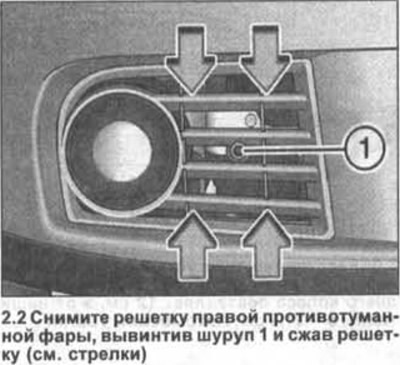Attention! After towing is complete, unscrew the tow hook and place it in its place in the vehicle tool kit. The hook must always be included in the on-board tool kit.
Golf
Installing the front tow hook
1. Remove the tow hook from the vehicle tool kit in the trunk.
2. Remove the grille of the right fog lamp by unscrewing the screw 1 and squeezing the grille (see arrows in illustration).

3. Screw the towing hook into the hole by hand until it stops, turning it to the left (see arrow in illustration). After that, insert a screwdriver or a balloon wrench into the hook and tighten the hook.

After towing is completed, unscrew the hook and reinstall the fog lamp grille.
Installing the rear tow hook
4. Lift the cover on the right side of the rear bumper that covers the hook hole.
5. Screw the towing hook into the hole by hand until it stops, turning it to the left. After that, insert a screwdriver or a balloon wrench into the hook and tighten the hook (see arrow in illustration).

Touran
Installing the front tow hook
6. Remove the cover (see arrow in illustration) on the right side of the bumper.

7. Screw the towing hook into the hole by hand until it stops by turning it counterclockwise to the left, and then tighten it with the balloon wrench in the direction of arrow A (see illustration).

Installing the rear tow hook
8. Open the cover on the bottom edge of the rear bumper by pushing it in.
9. Attach the tow hook to the hole as indicated for the front hook.
Towing Rules
10. Turn on the ignition on the towed vehicle. This is necessary in order for the steering, direction indicators, horn, windshield wipers and washers to function.
11. Place the shift lever in neutral or move the automatic transmission control lever to the position «N».
12. Turn on the hazard warning lights on the towing and towed vehicles.
It should be borne in mind that when the engine is not running, the power steering and brake drives do not work. When braking, apply more force to the brake pedal. More effort is needed for steering.
If there is no oil in the manual or automatic transmission, the vehicle must be towed with the drive wheels raised.
The use of a tow bar is recommended. When it is used, the danger of a collision between the towing and towed vehicles is eliminated. The tow rope must be flexible enough to protect both the vehicle being towed and the vehicle being towed from damage. Use only a rope made of synthetic fibers or with elastic intermediate links.
The driver of the towing vehicle must shift the gear smoothly, and the driver of the towed vehicle must monitor the cable tension.
The maximum permissible towing speed is 50 km/h.
The maximum allowable towing distance for an automatic vehicle is 50 km.
Towing to start the engine of the towed vehicle
Before resorting to towing to start the engine, try starting it on the battery of a running car. Starting the engine of a car with an automatic transmission by towing is not allowed.
Attention! When towing a car with a gasoline engine in order to start it, carry out at a distance of no more than 50 meters. Otherwise, catalytic converter damage cannot be ruled out.
13. Engage 2nd or 3rd gear, press and hold the clutch pedal.
14. Turn on the ignition.
15. Slowly release the clutch pedal when both vehicles start moving.
As soon as the engine starts, depress the clutch pedal and shift out of gear to avoid hitting the towing vehicle.

Visitor comments